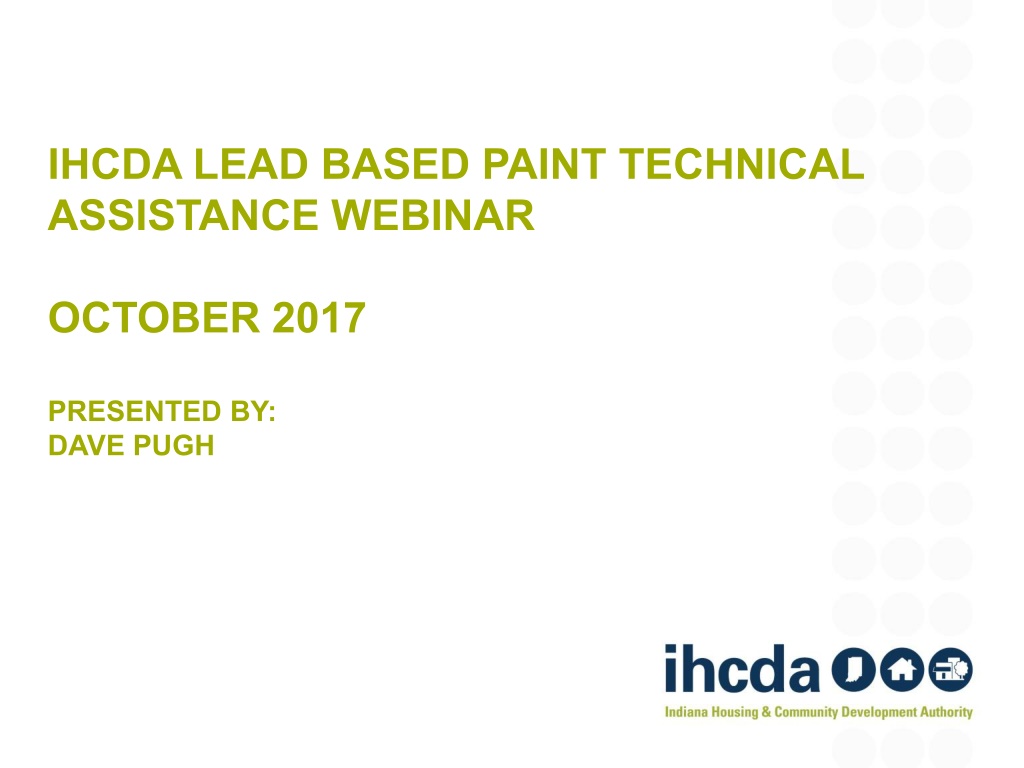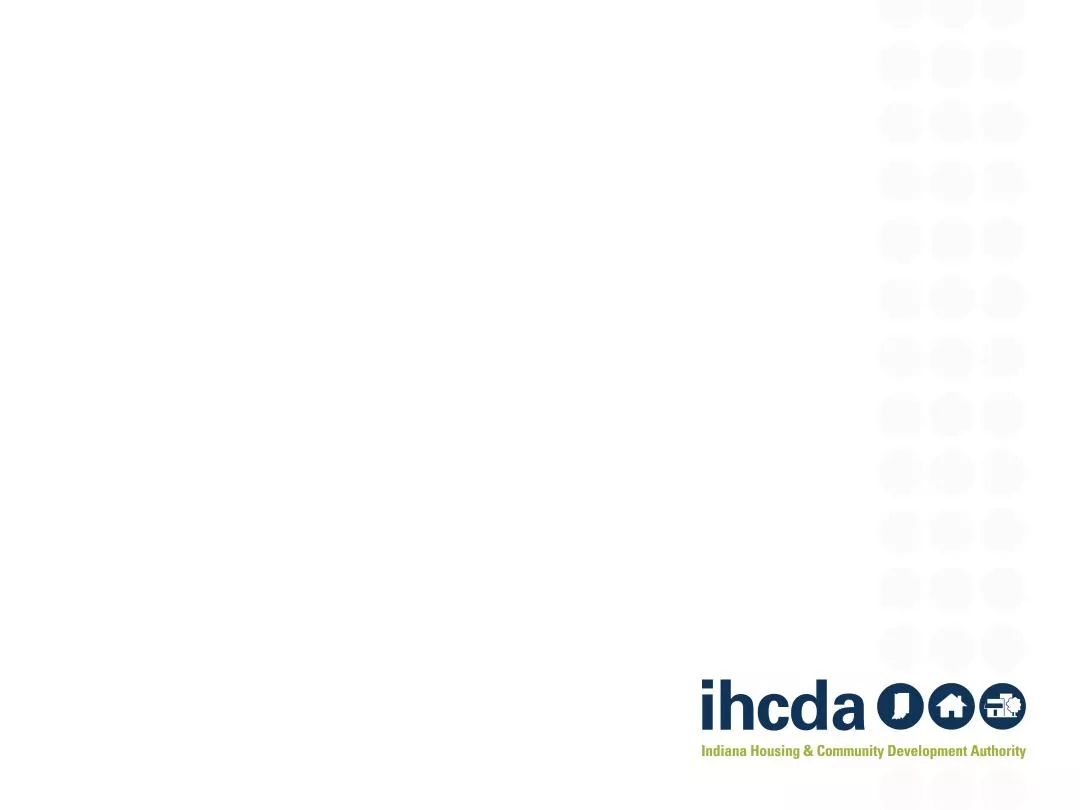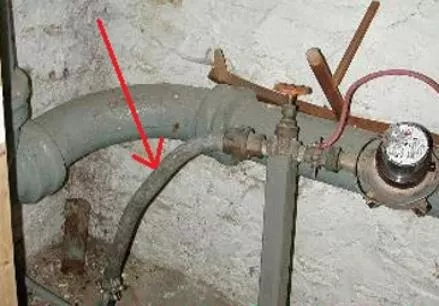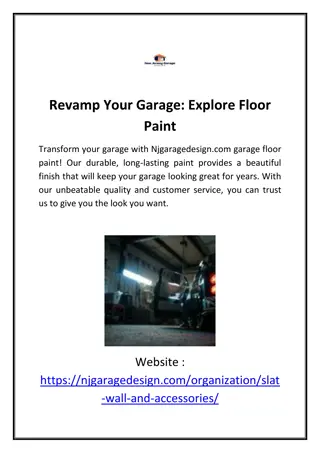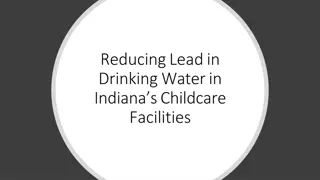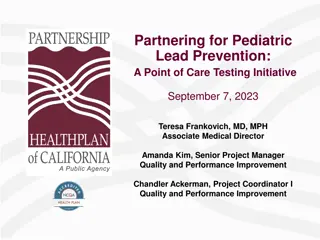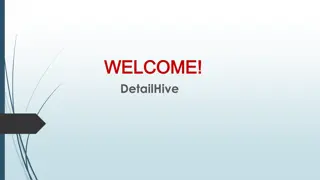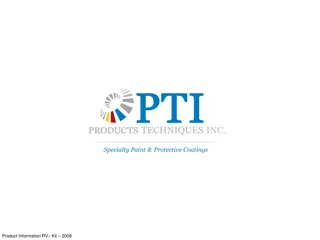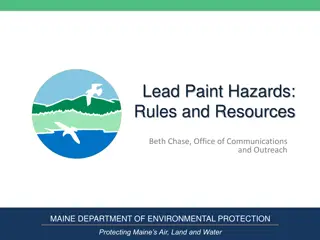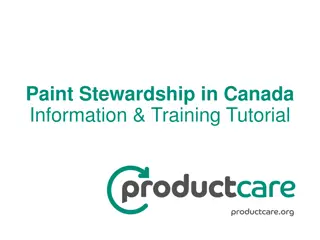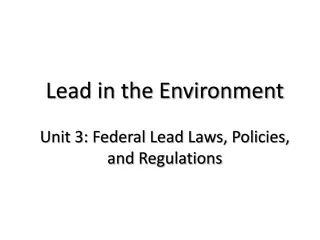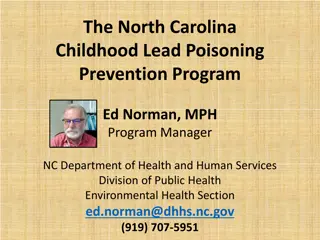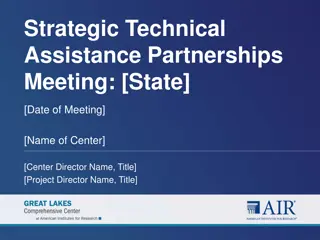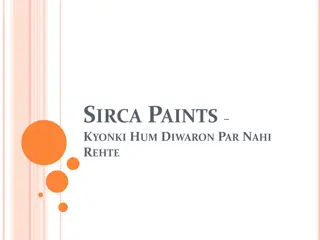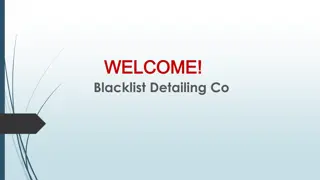Lead-Based Paint Technical Assistance Overview
This content provides an in-depth exploration of lead-based paint, covering its history, regulations, health effects, and the HUD's Lead Safe Housing Rule. It discusses the dangers of lead exposure, especially to children and pregnant women, and outlines the exemptions to the LSHR. The presentation sheds light on the significant events related to lead use, such as bans and regulations over the years. It also includes information on licensed requirements and aims to educate on the importance of lead safety in various industries.
Download Presentation

Please find below an Image/Link to download the presentation.
The content on the website is provided AS IS for your information and personal use only. It may not be sold, licensed, or shared on other websites without obtaining consent from the author.If you encounter any issues during the download, it is possible that the publisher has removed the file from their server.
You are allowed to download the files provided on this website for personal or commercial use, subject to the condition that they are used lawfully. All files are the property of their respective owners.
The content on the website is provided AS IS for your information and personal use only. It may not be sold, licensed, or shared on other websites without obtaining consent from the author.
E N D
Presentation Transcript
IHCDA LEAD BASED PAINT TECHNICAL ASSISTANCE WEBINAR OCTOBER 2017 PRESENTED BY: DAVE PUGH
PRESENTATION TODAY Overview and history of lead Rules and Regulations Licensing requirements Lead form Questions
LEAD: THE ORIGINAL ARTIFICIAL SWEETENER https://www.youtube.com/watch?v=CM1u29BeqC0
HISTORY OF LEAD Chemical element assigned the symbol Pb (Latin plumbum) Soft, malleable, low melting point, corrosion resistant, high denisty Used in paint, ceramics, pipes, gasoline, solders, batteries, cosmetics, etc. Lead used in paint to speed up drying time, increase durability, maintain a fresh appearance, resist moisture that causes corrosion, and because it adhered better than other types of paint 3000 BC- significant production began (Romans first to use widely) 1786- Ben Franklin writes letter detailing the effects of lead 1840- France discourages the use of lead pigment 1887- Us Medical authorities diagnose childhood lead poisoning 1904- Child lead poisoning linked to LBP 1909- France, Belgium, Austria ban white lead interior paint 1921- A national lead company admits lead is a poison 1922- League of Nations bans white-lead interior paint- the U.S. declines not to adopt 1943- Report concludes eating lead paint chips causes physical and neurological disorders 1971- Lead-based Paint Poisoning Prevention Act passed 1978- Residential lead-based painted banned
MOST AT RISK AND HEALTH EFFECTS Children age 6 and under: Nervous system and kidney damage Learning disabilities, attention deficit disorder, lower IQ Speech, language, and behavior issues Poor muscle coordination, decreased muscle and bone growth Hearing damage Pregnant women: Increased chance of illness during pregnancy Harm to a fetus, including brain damage or death Fertility problems High blood pressure Digestive problems Nerve disorders Memory and concentration problems Muscle and joint pain
HUDS LEAD SAFE HOUSING RULE (LSHR) 24 CFR Part 35 Covers all Federally-assisted or owned target housing Effective September 15, 2000 Requirements depend on type and amount of federal housing assistance https://www.hud.gov/program_offices/healt hy_homes/enforcement/lshr
EXEMPTIONS TO THE LSHR Any rehabilitation that does not disturb a painted surface Residential property for which construction was completed on or after Jan 1, 1978 Zero-bedroom units, including single room occupancy (SRO) units Housing exclusively for elderly or disabled (see HUD definition) in 35.110 Property evaluated as free of lead-based paint (LBP) or where LBP was removed Property or part of property that is not used for human residential habitation * Historic Preservation exemption- listed as eligible, or contributes to a historic district
NOTICE REQUIREMENTS EPA ( blue ) Pamphlet- Protect Your Family from Lead in Your Home Renovate Right- renovators must distribute to each family Notice of evaluation or presumption-within 15 days of receipt of report Notice of hazard reduction- within 15 days of completion
SUBPART J: REHABILITATION Up to $5,000 per unit hard costs Paint testing and repair Use Lead Safe Work Practices (LSWP) Clearance $5,000 up to $25,000 Risk assessment Interim Controls Clearance Over $25,000 per unit Paint testing & Risk Assessment Abatement of all identified LBP Hazards (Not all LBP) Clearance
LICENSING REQUIREMENTS The Indiana State Department of Health requires the following to be licensed: Risk Assessors Lead Inspectors Project Supervisor license (Abatement) Contractors (Abatement) Project Designer (Abatement) Worker License (Abatement) Clearance Examiner * RRP (renovate, repair, paint) required by EPA for all contractors https://www.in.gov/isdh/19153.htm I-Lead- managed by the ISDH https://gatewayp.isdh.in.gov/Gateway/SignIn.aspx
THREE BASIC REQUIREMENTS 1. Evaluation 2. Lead Hazard Control Plan- this is where de minimis is considered * Occupant Protection/Containment 3. Clearance
STEP #1: EVALUATION Paint testing- Testing lead content of: Deteriorated paint Painted surfaces to be disturbed or replaced Risk assessment On-site investigation to identify the existence, nature, severity and location of LBP hazards and provision of report Lead-based paint inspection Surface-by-surface investigation to determine presence of LBP and provision of report
STEP #2: LEAD HAZARD CONTROL PLAN Interim Controls Designed to temporarily eliminate LBP hazards Safe Work Practices Abatement Intent is to permanently eliminate LBP hazards Lead-Based Paint Hazards (rehab over $25,000) Refer to EPA 402 Rule (40 CFR 745) for work practice standards and certification requirements Safe Work Practices https://www.ecfr.gov/cgi-bin/text- idx?SID=4484117eb8d82ca1478eb8b4ea68e2dd&mc=true&node=se40.34.745_1227&rgn =div8
DE MINIMIS LEVELS Work which disturbs less than 20 square feet on exterior surfaces 2 square feet in any one interior room or space 10 percent of total surface area of interior or exterior component type with a small area (sills, baseboards, etc.) Exception to Safe Work Practices and Clearance only
ABATEMENT Intent is to permanently eliminate LBP or LBP hazard(s) Licensed contractors Methods include Encapsulation, enclosure, component replacement or removal of paint Paving or removal for soil Clearance by inspector or risk assessor https://portalapps.hud.gov/CORVID/HUDLBPAdvisor/info/documents /HUD-EPAabateguidance.pdf
STEP #3 CLEARANCE Two Parts: 1. 2. Visual Assessment Dust sampling Interim Dust Lead standards Conducted at least one hour after all work is completed Occupants notified of results within 15 calendar days Conducted by a licensed: Inspector Risk Assessor Clearance Examiner Final Payment to Contractor. A minimum of ten percent (10%) of the total contract must be held from the contractor until you receive a clearance report detailing that the levels of lead are within the acceptable range.
LEAD HAZARD CRITERIA FOR RISK ASSESSMENT Lead in dust (clearance/risk assessment) Floors Interior window sills Window troughs Lead in bare soil (risk assessment) Play areas Other soils 1,200 ppm 40 g/ft2 250 g/ft2 400 g/ft2 (clearance) 400 ppm
PROHIBITED WORK METHODS 1. Open flame burning 2. Machine sanding or grinding without HEPA control 3. Abrasive blasting or sandblasting without HEPA control 4. Heat guns over 1,100o F 5. Dry sanding or scraping (except with heat guns, within 1 foot of electrical outlets or on areas less than 2 sq. ft.) 6. Hazardous volatile paint strippers (e.g., methylene chloride)
OCCUPANT PROTECTION- RELOCATION Occupants shall be temporarily relocated before and during hazard reduction activities to a suitable, decent, safe, and similarly accessible dwelling unit that does not have lead-based paint hazards, except if: 1. Treatment will not disturb lead-based paint hazards or soil-lead hazards; 2. Only the exterior of the dwelling unit is treated, and windows, doors, ventilation intakes and other openings in or near the worksite are sealed during hazard control work and cleaned afterward, and entry free of dust-lead hazards, soil-lead hazards, and debris is provided; 3. Treatment of the interior will be completed within one (1) period of eight (8) daytime hours, the worksite is contained so as to prevent the release of leaded dust and debris into other areas, and treatment does not create other safety, health or environmental hazards
RELOCATION CONTINUED 4. Treatment of the interior will be completed within five (5) calendar days, the worksite is contained so as to prevent the release of leaded dust and debris into other areas, treatment does not create other safety, health, or environmental hazards and, at the end of work on each day, the worksite and the area within at least ten (10) feet (3 meters) of the containment area is cleaned to remove any visible dust or debris, and occupants have safe access to sleeping areas, and bathroom and kitchen facilities.
For Further Information Sign up for our email list for newsletters and notices If you want an IHCDA contact name for a specific program, let us know Contact Info: Dave Pugh Lead Grant Manager 317-234-6289 dpugh@ihcda.in.gov IHCDA Contact Info: 317-232-7777 askihcda@ihcda.in.gov
Thank you QUESTIONS?
